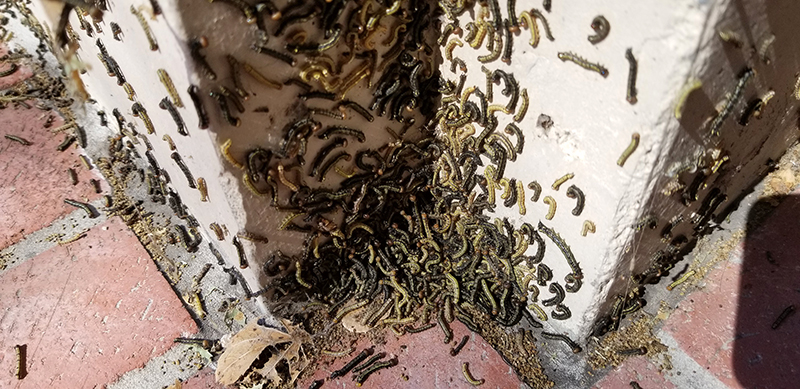Watch the KQED Deep Look video on California oak moths.




We are tracking outbreaks. Let us know if you notice a swarm of these moths or their caterpillars (essig.museum@gmail.com).
UPDATE: It looks like the oak moth population on the UC Berkeley campus will be larger than usual again this summer (2024).
The California oakworm or oak moth (Phryganidia californica) is a native moth from Southern California through Oregon and Washington. It is the only member of the subfamily Dioptinae (Lepidoptera: Notodontidae) found north of Mexico. In the San Francisco Bay Area the caterpillars feed largely on coast live oak (Quercus agrifolia), though other deciduous oaks are also on the menu. In most years they exist in small scattered populations.
Oak moths returned to the UC Berkeley campus for the second year in a row in 2020 – or more precisely, they never left. In June 2019 the Essig Museum received a call from a reporter at the Daily Cal asking about moths flying around oak trees on campus. Normally people do not notice the moths, but they certainly notice the onslaught of caterpillars eating the leaves of coast live oaks. By August many trees on campus were stripped bare. But by the end of October they recovered. In May-June 2020 we are witnessing the return of the oak moth.


The same tree at Sproul Hall: defoliated (August 15, 2019), recovered (October 3, 2019)
Oak moths typically have two generations per year – one in the spring and one in the fall. As of June 2020 we are seeing the spring caterpillars emerge as adult moths and laying eggs. These eggs will turn into caterpillars that will continue to defoliate trees in August and September. The caterpillars seem to focus on individual trees, rather than attacking all trees equally. This probably has to do with where the females lay their eggs, but the defensive chemistry of the oak trees may play some role.
This chemistry may also play a role in protecting the caterpillars and moths from birds and other predators. Many non-toxic moths and caterpillars hide during the day and feed at night. But oak moths and their caterpillars are very active during the day and do not seem to attract flocks of birds. Their main predators seem to be parasitoid wasps.


Feeding damage by Phryganidia caterpillars.
Once finished feeding on a tree, the caterpillars lower themselves by silk threads that can blow them to another tree to continue feeding, or to the ground where they will wander in search of a place to pupate. In nature these caterpillars would find a crack in the tree bark or side of a rock to anchor their pupal case (which looks more like a butterfly chrysalis). On campus these caterpillars can form masses on the sides of buildings, and sometimes crawl into utility access tubes.

Masses of caterpillars at Campbell Hall in August 2019.
